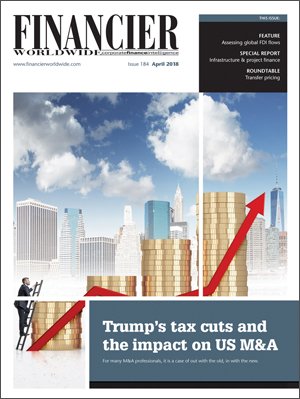Accelerating M&A deal cycles through automation
April 2018 | FEATURE | MERGERS & ACQUISITIONS
Financier Worldwide Magazine
Repeated often across the business world is the adage ‘time is money’. It is a realistic enough notion and one certainly applicable to the world of mergers & acquisitions (M&A), where deal value can be significantly inflated by speedy and efficient consolidation of systems and processes.
For sure, M&A transactions are often protracted affairs. According to a 2017 report by Deloitte – ‘NextGen M&A: the future of banking data conversions’ – the average duration from announcement to full operational integration is typically 15 to 20 months, a span primarily driven by regulatory requirements and complex technology conversions.
As a consequence of extended transactions, M&A practitioners are increasingly turning to automation to accelerate deal cycles, specifically next-generation tools such as robotic process automation (RPA), analytics, machine learning (ML) and artificial intelligence (AI) for rules-based and operational processes. In addition, cognitive intelligence, or intelligence augmentation (IA) technologies designed to assist rather than replace humans, is being utilised for predictive decision making.
The Deloitte report further notes that such next-generation tools increase the level of automation and efficiency across the following three components of an M&A transaction: (i) data sourcing and extraction; (ii) data remediation and transformation; and (iii) data entry and staging.
“Tools such as these transform traditionally manual processes such as system integration and data compilation,” says David Barnitt, president and founder of Attract Capital LLC. “The outcome of M&A is highly correlated to the speed and quality of operational integration. These tools will produce higher quality integrated systems including more accurate databases for customers, products and basic transactions. Synergy realisation speed will accelerate, resulting in a more integrated operation, fully capable of scaling its value drivers across a larger resource base.”
“In terms of automation as an ongoing feature of the M&A deal cycle, the consensus would appear to be that next-generation technologies will be more friend than foe in the years to come.”
In the experience of Mitchel Hoban, senior manager M&A at Deloitte Consulting LLP, synergy opportunity identification, capture and measurement are all dependent on the availability and analysis of large and reliable datasets. “Automation can be used to collect data across various unstructured data sources through optical character recognition (OCR), and cognitive intelligence can be used to sift through the data to provide insight into cost structures and spend data in order to identify synergy opportunities,” he suggests. “Synergy capture can then be clearly measured through the automation of ongoing data collection and analysis.”
Automation in practice
Clearly, there are numerous benefits to be gleaned from utilising automation during an M&A transaction. “Greater synergy realisation increases the strategic value of the acquisition for the buyer,” says Mr Barnitt. “If a buyer has an advantage relative to another buyer in capturing synergies, it can make a more competitive offer for the target company. RPA and cognitive intelligence also makes it easier for acquirers to compensate for the loss of institutional memory that inevitably takes place post-closing. Using RPA, companies will have a more systematic approach and better control over the process of synergy capture.
That said, automation, for all its advantages, is not devoid of shortcomings. “Automation can be difficult to implement, especially for organisations that are running on legacy systems with inconsistent data environments,” says Mr Hoban. “The key challenges in automating processes are often related to inconsistent, unavailable data and outdated systems.” According to Mr Barnitt, acquirers that use automation often have a harder time building the morale of employees post-closing. “Functions previously carried out by employees will be handled by RPA, which can create a level of mistrust and anxiety within the organisation,” he suggests.
So, although the adoption of next-generation technologies is becoming ever more widespread, deal makers would be wise not to view automation as a panacea and refrain from dispensing with the human element just yet.
Future applications
In terms of automation as an ongoing feature of the M&A deal cycle, the consensus would appear to be that next-generation technologies will be more friend than foe in the years to come.
“Automation will enable more value to be captured through M&A,” believes Mr Barnitt. “With more bulletproof automation, buyers will have higher confidence in their ability to seamlessly combine information systems and processes. This will ultimately result in more M&A deal volume and higher prices being paid for companies. It will also have a positive effect on the M&A dealmaker, due to higher earnings visibility and greater value creation possibilities.”
Similarly, Mr Hoban expects to see next-generation technologies accelerate the M&A cycle by reducing the amount of time required to separate and integrate business units. “This will result in lower transaction costs and allow businesses to quickly react to changing market conditions,” he explains. “The ability to quickly separate business segments and then integrate them with others by using automation and other next generation technologies will increase the pace at which large organisations are able to capture value through M&A.”
As 2018 shapes up to be another substantial year for global M&A, automation is expected to continue to play a major role. At all stages of the deal cycle, M&A practitioners have recourse to a variety of technologies and tools – automation that expediently paves the way for smart, fully reachable and achievable synergies.
© Financier Worldwide
BY
Fraser Tennant

